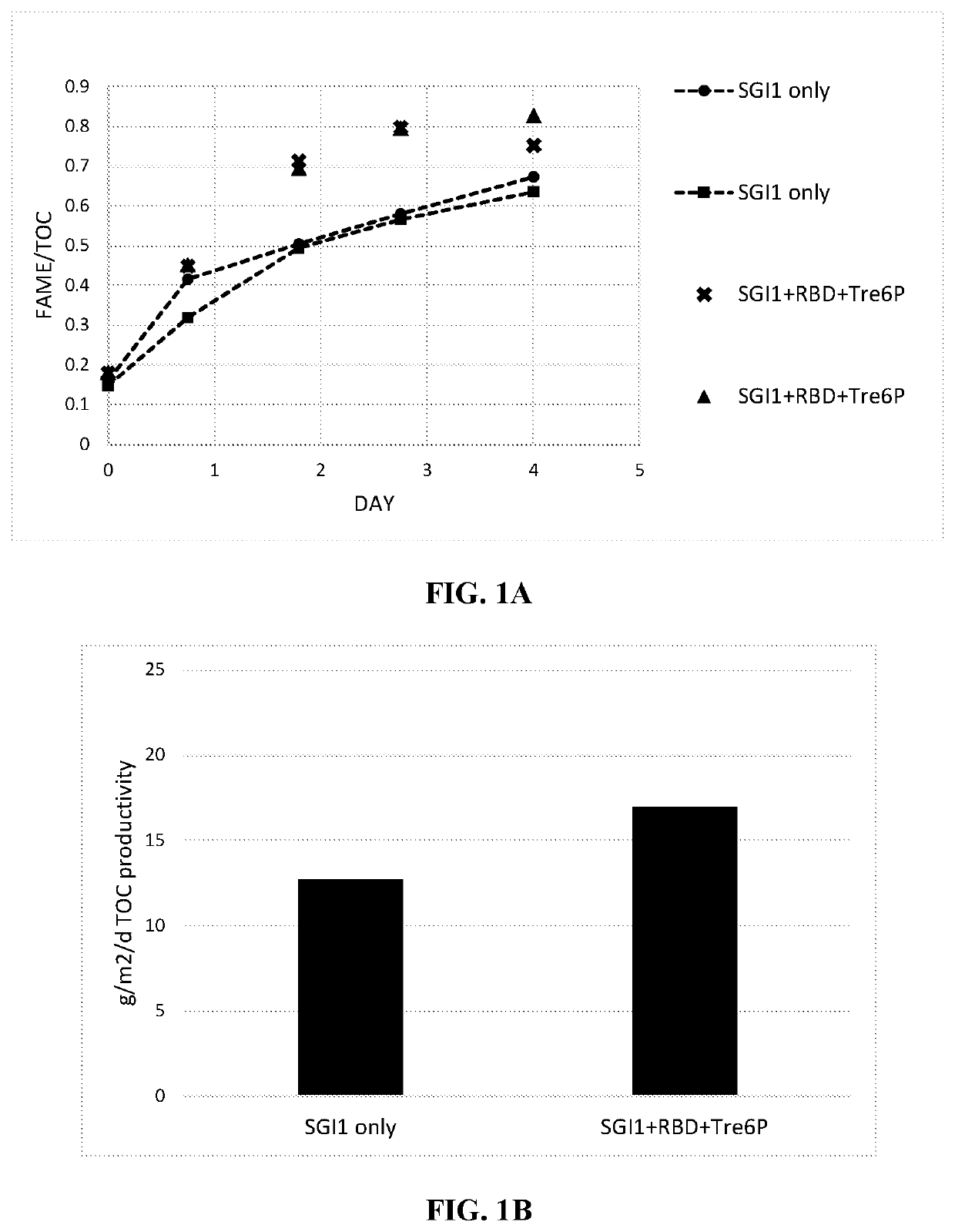Recombinant algae having high lipid productivity
- Summary
- Abstract
- Description
- Claims
- Application Information
AI Technical Summary
Benefits of technology
Problems solved by technology
Method used
Image
Examples
example 1
n of SGI1 Mutants
[0079]The production of algal strains containing a genetic modification in a nucleic acid sequence encoding an SGI1 polypeptide is known in the art and is detailed in US 2018 / 0186842, published Jul. 5, 2018, and which is hereby incorporated by reference in its entirety, including all tables, figures, and claims.
[0080]Briefly, wild-type Parachlorella sp. (a Chlorophyte, or green algae species) obtained from marine environments were mutagenized with uv radiation in a STRATALINKER® 2400 uv crosslinker (Agilent Technologies, Santa Clara, Calif.) and selected based on low chlorophyll fluorescence after low light acclimation.
[0081]The cells were grown to mid-log phase and then diluted to 1×106 (1e6) cells / mL with a nutrient replete growth medium. The cell suspensions were transferred to a Petri dish and placed within a STRATALINKER® 2400 UV crosslinker (Agilent Technologies, Santa Clara, Calif.) with the plate lid removed. UV irradiation was carried out with 10,000, 25,00...
example 2
is
[0085]The SGI1 mutants from Example 1 were irradiated with uv light in a STRATALINKER® 2400 uv crosslinker (Agilent Technologies®, Santa Clara, Calif.). Irradiation was done in four dosages with duplicates per dosage. Cells were diluted to a concentration of 5×106 (5e6) cells / ml and irradiated on agar plates with approximately 5×107 (5e7) cells total per petri dish. Irradiation dosages included 16 seconds at 27,000 uJ / cm2, 12 seconds at 20,000×uJ / cm2,8 seconds at 13,000 uJ / cm2, and 6 seconds at 10,000 uJ / cm2.
example 3
[0086]Mutagenized cells were then grown to a suitable concentration as measured by OD730 of 3.0 in flasks containing PM074 media. Cells were then transferred to media containing PM123 media (aquarium salts, PROLINE A®, and PROLINE (Pentair Aquatic Eco-Systems®, Inc.)) and a final OD730 of 0.1 (PROLINE A® and PROLINE B® together include 8.8 mM NaNO3, 0.361 mM NaH2PO4.H2O, 10× F / 2 Trace metals, and 10× F / 2 Vitamins (Guillard (1975) “Culture of phytoplankton for feeding marine invertebrates,” eds. Smith, W. L. and Chanley, M. H., Plenum Presse, New York, pp. 26-60). After growing to suitable concentration (OD730 of 2.8) cells were spun down in a centrifuge and re-suspended in flasks containing nitrogen-free PM67 media (aquarium salts, K2HPO4, vitamin mix, chelated trace metal mix). Cells were placed in a glass tank flask and a final concentration of cells of OD730 of 1.4 was reached and cells were placed under a constant stream of 1% CO2 in air.
[0087]After 48 hours of ...
PUM
| Property | Measurement | Unit |
|---|---|---|
| Fraction | aaaaa | aaaaa |
| Fraction | aaaaa | aaaaa |
| Fraction | aaaaa | aaaaa |
Abstract
Description
Claims
Application Information
 Login to View More
Login to View More - R&D
- Intellectual Property
- Life Sciences
- Materials
- Tech Scout
- Unparalleled Data Quality
- Higher Quality Content
- 60% Fewer Hallucinations
Browse by: Latest US Patents, China's latest patents, Technical Efficacy Thesaurus, Application Domain, Technology Topic, Popular Technical Reports.
© 2025 PatSnap. All rights reserved.Legal|Privacy policy|Modern Slavery Act Transparency Statement|Sitemap|About US| Contact US: help@patsnap.com



